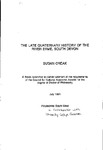THE LATE QUATERNARY HISTORY OF THE RIVER ERME, SOUTH DEVON
| dc.contributor.author | CREAK, SUSAN | |
| dc.contributor.other | School of Geography, Earth and Environmental Sciences | en_US |
| dc.date.accessioned | 2013-09-18T11:39:16Z | |
| dc.date.available | 2013-09-18T11:39:16Z | |
| dc.date.issued | 1991 | |
| dc.identifier | NOT AVAILABLE | en_US |
| dc.identifier.uri | http://hdl.handle.net/10026.1/1847 | |
| dc.description.abstract |
This thesis examines a typical 'drowned* river valley of south-west England. The River Erme drains southern Dartmoor and, in common, with other rivers of the region, has a buried channel graded to c. -50m OD. The channel has been infilled with a variety of sediments, of which the top 6-7m have been analysed for this study. Augered cores have been collected from the modern floodplain and salt marsh areas in the lower part of the valley and have been studied using particle size, diatom, molluscan and radiocarbon analyses. The main sediment types recovered include a fine silt unit representing the most recent phase of fluvial deposition, which overlies variable horizons of fluvial granitic sands and gravels and brackish organic sands and silts. These are, in places, replaced at depth by shelly silts, sands and gravels deposited under more estuarine and marine conditions. The organic layer has been radiocarbon dated to between 1000 and 2000 years BP and has been correlated with a former area of marshland recorded in the tithe maps of the region. It is suggested that the Erme valley was previously more estuarine than today and that alluviation and infilling of the Erme's channel in the last 1000-2000 years has been aided by forest clearance and tin mining on Dartmoor. All of the sediments recovered from the buried channel are derived from local sources of bedrock and have probably been deposited in the last 4000-6000 years. Evidence from the tithe maps suggests that the channel has been stable in the past 200 years. This work seeks to contribute to the Quaternary knowledge of the south-west of England, and because of the paucity of data concerning these burled rock channels, makes this study of the River Erme a preliminary model against which other rivers in the South West may be compared. | en_US |
| dc.description.sponsorship | University College, Swansea | en_US |
| dc.language.iso | en | en_US |
| dc.publisher | University of Plymouth | en_US |
| dc.title | THE LATE QUATERNARY HISTORY OF THE RIVER ERME, SOUTH DEVON | en_US |
| dc.type | Thesis | |
| plymouth.version | Full version | en_US |
| dc.identifier.doi | http://dx.doi.org/10.24382/3489 | |
| dc.identifier.doi | http://dx.doi.org/10.24382/3489 |
Files in this item
This item appears in the following Collection(s)
-
01 Research Theses Main Collection
Research Theses Main


